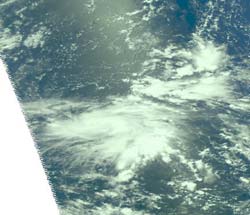NASA Tracks Tiny Tropical Storm Guchol in Western North Pacific

NASA's Aqua satellite passed over Tropical Storm Guchol on June 12 at 0335 UTC and captured a near-infrared image of the storm from the Atmospheric Infrared Sounder (AIRS) instrument. The infrared imagery indicates that convection and thunderstorms are consolidating over the low-level circulation center. Two tightly curved bands of thunderstorms are wrapping into the low-level center from the northeastern and southwestern quadrants of the storm.<br>Credit: NASA/JPL, Ed Olsen <br>
NASA's Aqua satellite passed over Tropical Storm Guchol on June 12 at 0335 UTC and captured a near-infrared image of the storm from the Atmospheric Infrared Sounder (AIRS) instrument. The infrared imagery indicates that convection (rising air that forms thunderstorms) and thunderstorms are consolidating over the low-level circulation center.
Two tightly curved bands of thunderstorms are wrapping into the low-level center from the northeastern and southwestern quadrants of the storm. Satellite imagery indicates that dry air along the northern edge of the storm is preventing thunderstorm formation, which accounts for the slow development of the storm, and the smaller size.
On June 12 at 1500 UTC (11 a.m. EDT/U.S.), Guchol, formerly known as Tropical Depression 05W, has maximum sustained winds near 65 knots (~75 mph/120.4 kph). It is located about 225 nautical miles east of Yap, near 9.7 North and 141.7 East. It is moving to the west at 7 knots (8 mph/13 kph). A tropical storm warning is in effect for Fais and Ulithi in Yap State, Micronesia.
Text Credit: Rob Gutro
NASA Goddard Space Flight Center, Greenbelt, Md.
Media Contact
All latest news from the category: Earth Sciences
Earth Sciences (also referred to as Geosciences), which deals with basic issues surrounding our planet, plays a vital role in the area of energy and raw materials supply.
Earth Sciences comprises subjects such as geology, geography, geological informatics, paleontology, mineralogy, petrography, crystallography, geophysics, geodesy, glaciology, cartography, photogrammetry, meteorology and seismology, early-warning systems, earthquake research and polar research.
Newest articles

Economies take off with new airports
A global study by an SUTD researcher in collaboration with scientists from Japan explores the economic benefits of airport investment in emerging economies using nighttime satellite imagery. Be it for…

CAR T–cell immunotherapy targets
Pan-cancer analysis uncovers a new class of promising CAR T–cell immunotherapy targets. Scientists at St. Jude Children’s Research Hospital found 156 potential CAR targets across the brain and solid tumors,…

Stony coral tissue loss disease
… is shifting the ecological balance of Caribbean reefs. The outbreak of a deadly disease called stony coral tissue loss disease is destroying susceptible species of coral in the Caribbean…





















